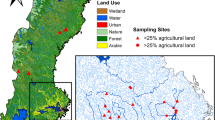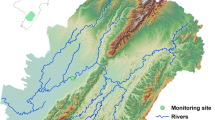Abstract
Total suspended solid (TSS) measurements in urban drainage systems are required for several reasons. Aiming to assess uncertainties in the mean TSS concentration due to the influence of sampling intake vertical position and vertical concentration gradients in a sewer pipe, two methods are proposed: a simplified method based on a theoretical vertical concentration profile (SM) and a time series grouping method (TSM). SM is based on flow rate and water depth time series. TSM requires additional TSS time series as input data. All time series are from the Chassieu urban catchment in Lyon, France (time series from 2007 with 2-min time step, 89 rainfall events). The probability of measuring a TSS value lower than the mean TSS along the vertical cross section (TSS underestimation) is about 0.88 with SM and about 0.64 with TSM. TSM shows more realistic TSS underestimation values (about 39 %) than SM (about 269 %). Interquartile ranges (IQR) over the probability values indicate that SM is more uncertain (IQR = 0.08) than TSM (IQR = 0.02). Differences between the two methods are mainly due to simplifications in SM (absence of TSS measurements). SM assumes a significant asymmetry of the TSS concentration profile along the vertical axis in the cross section. This is compatible with the distribution of TSS measurements found in the TSM approach. The methods provide insights towards an indicator of the measurement performance and representativeness for a TSS sampling protocol.







Similar content being viewed by others
References
Ahyerre M. (1999). Bilan et mécanismes de migration de la pollution organique en réseau d’assainissement unitaire. PhD Thesis, University Paris 6, France, 250 p. (in French).
Ashley, R. M., & Crabtree, R. W. (1992). Sediment origins, deposition and build-up in combined sewer systems. Water Science and Technology, 25(8), 1–12.
Ashley, R. M., Arthur, S., Coghlan, B. P., & McGregor, I. (1994). Fluid sediment in combined sewers. Water Science Technology, 29(1–2), 113–123.
Ashley, R. M., Bertrand-Krajewski, J.-L., Hvitved-Jacobsen, T., & Verbanck, M. (Eds.). (2004). Solids in sewers (p. 360). London: IWA Publishing. Scientific and Technical Report n° 14, May 2004.
Berg, E. L. (1982). Handbook for sampling and sample preservation of water and wastewater—Report EPA-600/4-82-029. Washington (USA): United States Environmental Protection Agency.
Bertrand-Krajewski, J.-L., & Muste, M. (2007). Chapter 8—data validation: principles and implementation. In T. Fletcher & A. Deletic (Eds.), Data requirements for integrated urban water management (pp. 103–126). London (UK): Taylor and Francis, Urban Water series - UNESCO IHP.
Cantero‐Chinchilla, F. N., Castro‐Orgaz, O., & Dey, S. (2016). Distribution of suspended sediment concentration in wide sediment‐laden streams: a novel power‐law theory. Sedimentology. doi:10.1111/sed.12276. Accepted manuscript online: 21 Feb. 2016.
Chebbo, G., & Gromaire, M.-C. (2004). The experimental urban catchment ‘Le Marais’ in Paris: what lessons can be learned from it? Journal of Hydrology, 299, 312–323.
Chebbo, G., & Gromaire, M.-C. (2009). ViCAs—an operating protocol to measure the distributions of suspended solid settling velocities within urban drainage samples. Journal of Environmental Engineering, 135(9), 768–775.
Coleman, N. L. (1982). Discussion of paper 16313. Journal of Hydraulics Division ASCE, 108(1), 164–165.
ISO. (2009). ISO/IEC guide 98-1:2009(E) uncertainty of measurement—part 1: introduction to the expression of the uncertainty in measurement (p. 32). Geneva: ISO. September 2009.
Joannis, C., Ruban, G., Gromaire, M.-C., Bertrand-Krajewski, J.-L., & Chebbo, G. (2008). Reproducibility and uncertainty of wastewater turbidity measurements. Water Science and Technology, 57(10), 1667–1673.
Kafi-Benyahia, M., Gromaire, M.-C., & Chebbo, G. (2006). Representativity of samplings by automatic vacuometric samplers in combined sewer: case of OPUR. La Houille Blanche, 4, 113–120.
Larrarte, F. (2008). Suspended solids within sewers: an experimental study. Environmental Fluid Mechanics, 8(3), 249–261.
Larrarte, F. (2015). Velocity and suspended solids distributions in an oval-shaped channel with a side bank. Urban Water, 12(2), 165–173.
Larrarte, F., & Pons, M.-N. (2011). Suspended solids concentration in wastewater: influence of sampling conditions. Urban Water Journal, 8(6), 397–404.
Métadier M. (2011). Traitement et analyse de séries chronologiques continues de turbidité pour la formulation et le test de modèles des rejets urbains par temps de pluie. PhD Thesis, INSA Lyon, France, 339 p. + appendices (in French).
Métadier, M., & Bertrand-Krajewski, J.-L. (2011). From mess to mass: a methodology for calculating storm event pollutant loads with their uncertainties, from continuous raw data time series. Water Science and Technoloy, 63(3), 369–376.
Métadier, M., & Bertrand-Krajewski, J.-L. (2012). Pollutographs, concentrations, loads and intra-event mass distributions of pollutants in urban wet weather discharges calculated from long term on line turbidity measurements. Water Research, 46(20), 6836–6856.
Muste, M., Lee, K., & Bertrand-Krajewski, J.-L. (2012). Standardized uncertainty analysis for hydrometry: a review of relevant approaches and implementation examples. Hydrological Sciences Journal, 57(4), 643–667.
Raudkivi, A. J. (1998). Loose boundary hydraulics (p. 512). Rotterdam (Netherlands): Taylor & Francis.
Ristenpart E. (1995). Feststoffe in der Mischwasserkanalisation: Vorkommen, Bewegung und Verschmutzungs-potential, PhD Thesis, University of Hannover, Germany (in German).
Ristenpart, E., Ashley, R. M., & Uhl, M. (1995). Organic near-bed fluid and particulate transport in combined sewers. Water Science and Technology, 31(7), 61–68.
Rossi L. (1998). Qualité des eaux de ruissellement urbaines. PhD Thesis, Swiss Federal Institute of Technology, Lausanne, Switzerland, 416 p. (in French).
Shelley, P. E. (1977). Sampling of water and wastewater (pp. 272–664). Cincinatti: Environmental Protection Agency.
Torres A. (2008). Décantation des eaux pluviales dans un ouvrage réel de grande taille : éléments de réflexion pour le suivi et la modélisation. PhD Thesis, INSA Lyon, France, 368 p. (in French).
Torres, A., & Bertrand-Krajewski, J.-L. (2008). Evaluation of uncertainties in settling velocities of particles in urban stormwater runoff. Water Science and Technology, 57(9), 1389–1396.
Verbanck, M. A. (1993). Identification of the depth-dependent transportation of particulate solids in dry weather sewage flows. Proceedings of 6th International Conference on Urban Storm Drainage, Niagara Falls, Canada, 742–747.
Verbanck, M. A. (1995). Capturing and releasing settleable solids: the significance of dense undercurrents in combined sewer flows. Water Science and Technology, 31(7), 85–93.
Verbanck, M. A. (2000). Computing near-bed solids transport in sewers and similar sediment-carrying open-channel flows. Urban Water, 2(4), 277–284.
Acknowledgments
The data used in this work have been collected and made available by the OTHU project in Lyon, France (see www.othu.org). Santiago Sandoval is grateful to COLCIENCIAS (Colombian Institute for the Development of Science and Technology) for funding his PhD studies in France.
Author information
Authors and Affiliations
Corresponding author
Rights and permissions
About this article
Cite this article
Sandoval, S., Bertrand-Krajewski, JL. Influence of sampling intake position on suspended solid measurements in sewers: two probability/time-series-based approaches. Environ Monit Assess 188, 347 (2016). https://doi.org/10.1007/s10661-016-5335-y
Received:
Accepted:
Published:
DOI: https://doi.org/10.1007/s10661-016-5335-y




